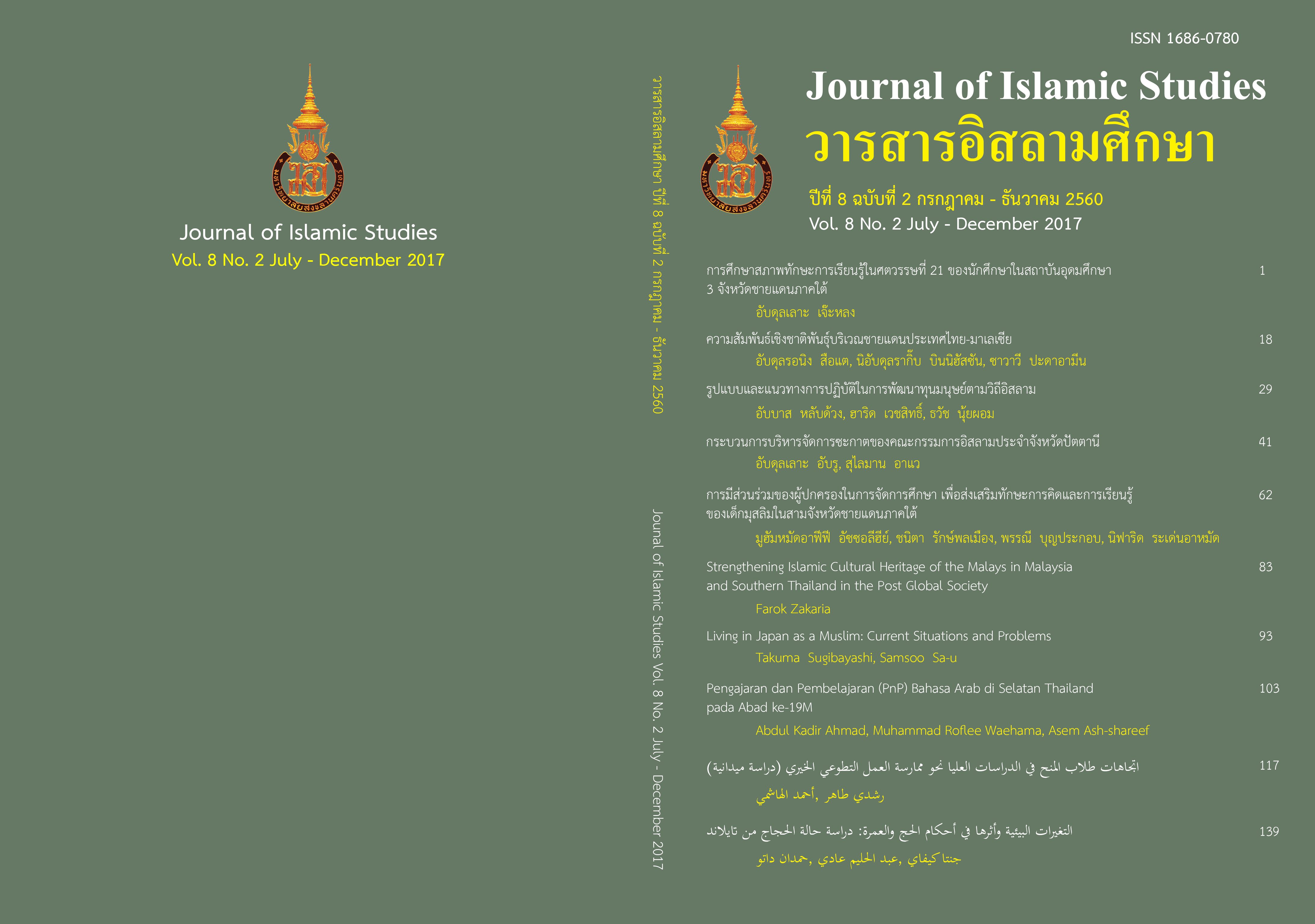Living in Japan as a Muslim: Current Situations and Problems
คำสำคัญ:
Muslim, Japan, Current situations, Problemsบทคัดย่อ
The world's Muslim population has been constantly increasing over the years. Japan, too, has experienced/ observed an increase in the number of Muslims residing in the country. Being Muslim in a non-Muslim country is not easy. Therefore, Muslims in Japan have encountered a variety of hardships trying to live out their faith in Japan. The difficulties of following Muslim orthodox as it is done in Muslim-majority countries have led many Muslims in Japan to adopt a more flexible and compromising way of practicing their faith. Muslims face problems no matter where they are in the country, and without government regulations there are no consistent standards, particularly regarding what is Halal and otherwise. There is a serious lack of trust that Halal brands are in fact Halal. By pointing out problems that Muslim residents are currently facing and knowing how they deal with the problems, the current circumstances could be improved. Thus, this paper tries to recognize the current Muslim situations and identify current problems in order to reach effective solutions in the future.
เอกสารอ้างอิง
Central Intelligence Agency. (2012). The World Factbook: Japan. Retrieved on Sep. 13, 2017. https://www.cia.gov/library/publications/the-world-factbook/geos/ja.html
Chikushi, Yuji. (2014). “Is That Halal Ok? A Boom in Establishing Halal Certification Organizations.” Toyo Keizai Online. 12 July 2014. Retrieved on 20 September, 2017 <.http://toyokeizai.net/articles/-/42051>
Hackett Conrad and McClendon David (2017) “Christians Remain World’s Largest Religious Group, but They are Declining in Europe.” Pew Research Center. Retrieved on Sep 06, 2017. http://www.pewresearch.org/fact-tank/2017/04/05/christians-remain-worlds-largest-religious-group-but-they-are-declining-in-europe/
Islamic Center of Japan. (2009). Islam History of Japan. Islamic Center of Japan. Retrieved on Sep 06, 2017. http://islamcenter.or.jp/history-and-publications/history-of-islam-in-japan/.
Japan External Trade Organization (JETRO). (2017). Procedure for Halal Certification. NOV 2017. Retrieved on 18 December, 2017 < https://www.jetro.go.jp/world/qa/04A-090901.html >
Kanda, Daisuke. (2017). “On the Day of Decision to be Muslim, Go to a Pork Cutlet Restaurant. But now…: A Life of a Japanese Muslim.” Withnews. 28 May 2017. Retrieved on 20 September, 2017. https://withnews.jp/article/f0170528001qq 000000000000000W03510101qq000015174A
Kishida, Yumi. (2009). Research on University Practices to Accommodate Religious Needs of Muslim Students: Case study of Japan and Australia. Kanazawa University College of Science and Engineering. March 2009.
Komura Akiko. (2015). Japanese Spirituality Seen from the History of Islam in Japan. Language, Culture, and Communication: Journal of the College of Intercultural Communication.
Ministry of Agriculture, Forestry and Fisheries. (2015). A Survey Regarding Halal Products in 2015.
Ministry of Education, Culture, Sports, Science and Technology. the Basic Act on Education. Retrieved on Sep. 15, 2017. http://www.mext.go.jp/b_menu/kihon/data/07080117.htm
Ministry of Foreign Affairs of Japan. (2014). Turkey and Japan: Establishment of Diplomatic Relations 90 Years, Diplomatic Archives of the Ministry of Foreign Affairs of Japan.
Nakano, Sachiko, Okunishi, Yuri and Tanaka, Tomoko. (2015). Social Life Difficulties of Muslim Students in Japan. The Bulletin of Graduate School of Humanities and Social Sciences, Okayama University No. 39. March 2015.
Nouh, Samir A. (2012). Muslims in Japan with the Comparison of Those in Europe Intercultural Research Center (IREC) Kobe University. October 31, 2012
Saito, Takehiro. (2012). “A Japanese Convert to Islam: A Case of a Journalist, Kosuke Tsuneoka.” Nikkan Spa. Fusosha Publishing Inc. 13 Matrch 2012. Retrieved on 20 September, 2017. https://nikkan-spa.jp/170177
Shizuoka Newspaper. (2017). “Worries about School Life, School Lunch. Understand Muslim Children.” (07 FEB, 2017). Retrieved on Sep. 16, 2017. http://www.at-s.com/news/article/topics/shizuoka/326523.html
Statistic Bureau. (2014). Population Estimates 2014. Retrieved on Sep. 13, 2017. http://www.stat.go.jp/data/jinsui/2014np/
Tagawa, Motonari. (2017). Existing Home, Prefabricated House – Japanese Masjids and Islamic Society. 12 OCT 2017. Retrieved on Oct. 12, 2017 <https://news.yahoo.co.jp/feature/773>
Tanada, Hirofuni. (2015). Muslim Population in the World and Japan, 2013. Muslims in Japan No.14. Institute for Multi-Ethnic and Multi-Generational Societies, Waseda University.
Tanada, Hirofuni and Okai, Hirofumui. (2009). Survey on Mosques in Japan 2: Report on Islamic Worship Facilites. Muslims in Japan No.3. Institute for Multi-Ethnic and Multi-Generational Societies, Waseda University.
Tanada, Hirofuni and Okai, Hirofumui. (2010). Survey on Muslim Child Education in Japan. Muslims in Japan No.6. Institute for Multi-Ethnic and Multi-Generational Societies, Waseda University.
Tanada, Hirofuni and Okai, Hirofumui. (2015). “Islam in Japan: Current Situations and Problems in Muslim Community” News on Religious Affairs No. 119. Agency for Cultural Affairs.
Usmanova, Larisa. (2006). Review of Historical Materials Related to the Pre-war History of Turko-Tatar Emigre in the Eastern Asia. Institute for North East Asian Research, The University of Shimane
ดาวน์โหลด
เผยแพร่แล้ว
รูปแบบการอ้างอิง
ฉบับ
ประเภทบทความ
สัญญาอนุญาต
บทความทุกเรื่อง ที่ได้รับการตีพิมพ์ในวารสารอิสลามศึกษาเป็นแนวคิดของผู้เขียน มิใช่เป็นความคิดเห็นคณะผู้จัดทำและมิใช่ความรับผิดชอบของคณะวิทยาการอิสลาม กองบรรณาธิการไม่สงวนสิทธิ์การคัดลอก แต่ให้มีการอ้างอิงแสดงที่มา




